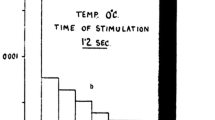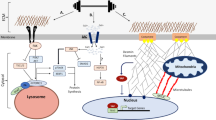Abstract
Potential complexities in biochemical and bioenergetic interpretation due to fiber type heterogeneity are not significant for human muscle. Paradigms for understanding muscle bioenergetics then can be understood from a set of basic premises of biochemical energy balance 1) ATP provides the energy for all forms of muscle work; 2) chemical energy is stored in cells as phosphocreatine, a biochemical capacitor; 3) the sum of the coupled ATPases sets the demand side of the balance and defines energetic states; and 4) this demand is supplied by aerobic metabolism and the products of the coupled ATPases provide control signals for regulation of energy balance. We speculate that cytoplasmic signals at work in energy balance may also control muscle plasticity.
Access this chapter
Tax calculation will be finalised at checkout
Purchases are for personal use only
Preview
Unable to display preview. Download preview PDF.
Similar content being viewed by others
References
Arnold DL, Matthews PM & Radda GK (1984). Metabolic recovery after exercise and the assessment of mitochondrial function in vivo in human skeletal muscle by means of 31P NMR. Magnetic Resonance in Medicine 1, 307–315.
Blei ML, Conley KE, Odderson IR, Esselman PC & Kushmerick MJ (1993). Individual variation in contractile cost and recovery in human skeletal muscle. Proceeding of the National Academy of Science, USA 90, 7396–7400.
Bloch G, Chase JR, Meyer DB, Avison MJ, Shulman GI & Shulman RG (1994). In vivo regulation of rat muscle glycogen resynthesis after intense exercise. American Journal of Physiology (Endocrine Metabolism) 266, E85–E91.
Bottinelli R, Schiaffino S & Reggiani C (1991). Force-velocity relations and myosin heavy chain isoform compositions of skinned fibres from rat skeletal muscle. Journal of Physiology (London) 437, 655–672.
Brown GC (1992). Control of Respiration and ATP synthesis in mammalian mitochondria and cells. Biochemical Journal 284, 1–13.
Chance B, Leigh J, Kent J, McCully K, Nioka S, Clark BJ & Maris JM (1986). Multiple controls of oxidative metabolism in living tissues as studied by phosphorus magnetic resonance. Proceedings of the National Academy of Science, USA 83, 9458–9462.
Conley KE (1994). Cellular energetics during exercise. Advances in Veterinary Science and Comparative Medicine 38A, 1–39.
Connett RJ (1988). Analysis of metabolic control: new insights using scaled creatine kinase model. American Journal of Physiology 254, R949–R959.
Crow MT & Kushmerick MJ (1982). Chemical energetics of slow-and fast-twitch muscles of the mouse. Journal of General Physiology 79, 147–166.
Das AM & Harris DA (1990). Regulation of the mitochondrial ATP synthase in intact rat cardiomyocytes. Biochemical Journal 266, 355–361.
Edstrom L, Hultman E, Sahlin K & Sjoholm H (1982). The contents of high-energy phosphates in different fibre types in skeletal muscles from rat, guinea-pig, and man. Journal of Physiology (London) 332, 47–58.
Firth JD, Ebert BL, Pugh CW & Ratcliffe PJ (1994). Oxygen-regulated control elements in the phosphoglycerate kinase 1 and lactate dehydrogenase A genes: Similarities with the erythropoietin 3’ enhancer. Proceedings of the National Academy of Science, USA 91, 6496–6500.
Goldberg MA, Dunning SP & Bunn HF (1988). Regulation of the erythropoietin gene: evidence that the oxygen sensor is a heme protein. Science 242, 1412–1414.
Gollnick PD, Armstrong RB, Sembrowich WL, Shepherd RE & Saltin B (1973). Glycogen depletion pattern in human skeletal muscle fibers after heavy exercise. Journal of Applied Physiology 34, 615–618.
Greenhaff PL, Söderlund K, Ren JM & Hultman E (1993). Energy metabolism in single human muscle fibres during intermittent contraction with occluded circulation. Journal of Physiology (London) 460, 443–453.
Heineman FW & Balaban RS (1990). Control of mitochondrial respiration in the heart in vivo. Annual Review of Physiology 52, 523–542.
Hintz, CS, Chi M M-Y, Fell RD, Ivy JL, Kaiser KK, Lowry CV & Lowry OH (1982). Metabolite changes in individual rat muscle fibers during stimulation. American Journal of Physiology 242, C218–C228.
Hofmann PA, Hartzell HC & Moss RL (1991). Alterations in Ca2+ sensitive tension due to partial extraction of C-protein from rat skinned cardiac myocytes and rabbit skeletal muscle fibers. Journal of General Physiology 97, 1141–1163.
Kushmerick MJ (1977). Energy balance in muscle contraction: A biochemical approach. In: Sanadi R (ed.), Current Topics in Bioenergetics, vol. 6, pp. 1–15. New York: Academic Press.
Kushmerick MJ (1983). Energetics of muscle contraction. In: Peachey L, Adrian R, Geiger SR (eds.), Handbook of Physiology, Skeletal Muscle, pp. 189–236. Bethesda: American Physiological Society.
Kushmerick MJ & Davies RE (1969). The chemistry, efficiency and power of maximally working sartorius muscles. Proceedings of the Royal Society, London B, 315-353.
Kushmerick MJ & Meyer RA (1985). Chemical changes in rat leg muscle by phosphorus nuclear magnetic resonance. American Journal of Physiology 248, C542–C549.
Kushmerick MJ, Moerland TS & Wiseman RW (1992). Mammalian skeletal muscle fibers distinguished by contents of phosphocreatine, ATP, and Pi. Proceedings of the National Academy of Science, USA 89, 7521–7525.
Kushmerick MJ, Moerland TS & Wiseman RW (1993). Two classes of mammalian skeletal muscle fibers distinguished by metabolite content. Advances in Experimental Medicine and Biology 332, 749–761.
Kushmerick MJ & Paul RJ (1976). Aerobic recovery metabolism following a single isometric tetanus in frog sartorius muscle at 0°C. Journal of Physiology (London) 254, 693–709.
Larsson L & Moss RL (1993). Maximum velocity of shortening in relation to myosin isoform composition in single fibres from human skeletal muscles. Journal of Physiology (London) 472, 595–614.
Lipmann F (1941). Metabolic generation and utilization of phosphate bond energy. In: Nord FF, Werkman CH (eds.), Advances in Enzymology, vol 1, pp. 99–162. New York: Intersciences Publishers, Inc.
McCormack JG & Denton RM (1990). Ca2+ as a second messenger within mitochondria in the heart and other tissues. Annual Review of Physiology 52, 451–466.
McCormack JG & Denton RM (1993). The role of intramitochondrial Ca2+ in the regulation of oxidative phosphorylation in mammalian tissues. Biochemical Society Transactions 21, 793–799.
Metzger JM & Moss RL (1987). Shortening velocity in skinned single muscle fibers. Biophysical Journal 52, 127–8131.
Meyer RA (1989). Linear dependence of muscle phosphocreatine kinetics on total creatine content. American Journal of Physiology 257, C1149–C1157.
Meyer RA, Brown TR, Krilowicz BL & Kushmerick MJ (1986). Phosphagen and intracellular pH changes during contraction of creatine-depleted rat muscle. American Journal of Physiology 250, C264–C274.
Meyer RA, Brown TR, Kushmerick MJ (1985). Phosphorus nuclear magnetic resonance of fast-and slowtwitch muscle. American Journal of Physiology 248, C279–C287.
Meyer RA, Dudley GA & Terjung RL (1980). Ammonia and IMP in different skeletal muscle fibers after exercise in rats. Journal of Applied Physiology 49, 1037–1041.
Meyer RA, Sweeney HL & Kushmerick MJ (1984). A simple analysis of the “phosphocreatine shuttle.” American Journal of Physiology 246, C365–C377.
Meyer RA & Terjung RL (1979). Differences in ammonia and adenylate metabolism in contracting fast and slow muscle. American Journal of Physiology 237, C111–C118.
Mizuno M, Secher NH & Quistorff B (1994). 31P-NMR spectroscopy, rsEMG, and histochemical fiber types of human wrist flexor muscles. Journal of Applied Physiology 76, 531–538.
Moerland TS, Wolf NG & Kushmerick MJ (1989). Administration of a creatine analogue induces isomyosin transitions in muscle. American Journal of Physiology 257, C810–C816.
Pette D & Staron RS (1990). Cellular and molecular diversity of mammalian skeletal muscle fibers. Reviews of Physiology, Biochemistry & Pharmacology 116, 1–76.
Pette D & Vrbova G (1992). Adaptation of mammalian skeletal muscle fibers to chronic electrical stimulation. Reviews of Physiology, Biochemistry & Pharmacology 120, 115–202.
Price TB, Rothman DL, Taylor R, Avison MJ, Shulman GI & Shulman RG (1994). Human muscle glycogen resynthesis after exercise: Insulin-dependent and-independent phases. Journal of Applied Physiology 76, 104–111.
Ren J-M & Hultman E (1989). Regulation of glycogenolysis in human skeletal muscle. Journal of Applied Physiology 67, 2243–2248.
Saltin B & Gollnick PD (1983). Skeletal muscle adaptability: significance for metabolism and performance. In: Geiger SR, Adrian RH (eds.), Peachey LD (sec. ed.), Handbook of Physiology, sec. 10, Skeletal Muscle, pp. 555-631. Bethesda, MD: American Physiological Society.
Shoubridge EA, Challiss RAJ, Hayes DJ & Radda GK (1985). Biochemical adaptation in the skeletal muscle of rats depleted of creatine with the substrate analogue B-guanidinopropionic acid. Biochemical Journal 232, 125–131.
Söderlund K & Hultman E (1991). ATP and phosphocreatine changes in single human muscle fibers after intense electrical stimulation. American Journal of Physiology (Endocrine Metabolism) 261, E737–E741.
Sweeney HL, Kushmerick MJ, Mabuchi K, Sreter FA & Gergely J (1988). Myosin alkali light chain and heavy chain variations correlate with altered shortening velocity of isolated skeletal muscle. Journal of Biological Chemistry 263, 9034–9039.
Taylor DJ, Bore PJ, Styles P, Gadian DG & Radda GK (1983). Bioenergetics of intact human muscle. A 31P nuclear magnetic resonance study. Molecular Biology & Medicine 1, 77–94.
Vandenborne K, McCully K, Kakihira H, Prammer M, Bolinger L, Detre JA, De Meirleir K, Walter G, Chance B & Leigh JS (1991). Metabolic heterogeneity in human calf muscle during maximal exercise. Proceedings of the National Academy of Science, USA 88, 5714–5718.
Vandenborne K, Walter G, Goelman G, Ploutz L, Dudley G & Leigh JS (1993a). Phosphate content of fast and slow twitch muscles. Proceedings of the Society of Magnetic Resonance in Medicine 3, 1140.
Vandenbome K, Walter G, Leigh JS & Goelman G (1993b). pH heterogeneity during exercise in localized spectra from single human muscles. American Journal of Physiology (Cell Physiology) 265, C1332–C1339.
Wallimann T, Wyss M, Brdiczka D, Nicolay K & Eppenberger HM (1992). Intracellular compartmentation, structure and function of creatine kinase isoenzymes in tissues with high and fluctuating energy demands: the ‘phosphocreatine circuit’ for cellular energy homeostasis. Biochemical Journal 281, 21–40.
Wilkie DR (1960). Thermodynamics and the interpretation of biological heat measurements. Progress in Biophysics and Biophysical Chemistry 10, 260–298.
Woledge RC, Curtin NA & Homsher E (eds.) (1986). Energetic Aspects of Muscle Contraction. New York: Academic Press.
Author information
Authors and Affiliations
Editor information
Editors and Affiliations
Rights and permissions
Copyright information
© 1995 Springer Science+Business Media New York
About this chapter
Cite this chapter
Kushmerick, M.J. (1995). Bioenergetics and Muscle Cell Types. In: Gandevia, S.C., Enoka, R.M., McComas, A.J., Stuart, D.G., Thomas, C.K., Pierce, P.A. (eds) Fatigue. Advances in Experimental Medicine and Biology, vol 384. Springer, Boston, MA. https://doi.org/10.1007/978-1-4899-1016-5_14
Download citation
DOI: https://doi.org/10.1007/978-1-4899-1016-5_14
Publisher Name: Springer, Boston, MA
Print ISBN: 978-1-4899-1018-9
Online ISBN: 978-1-4899-1016-5
eBook Packages: Springer Book Archive




